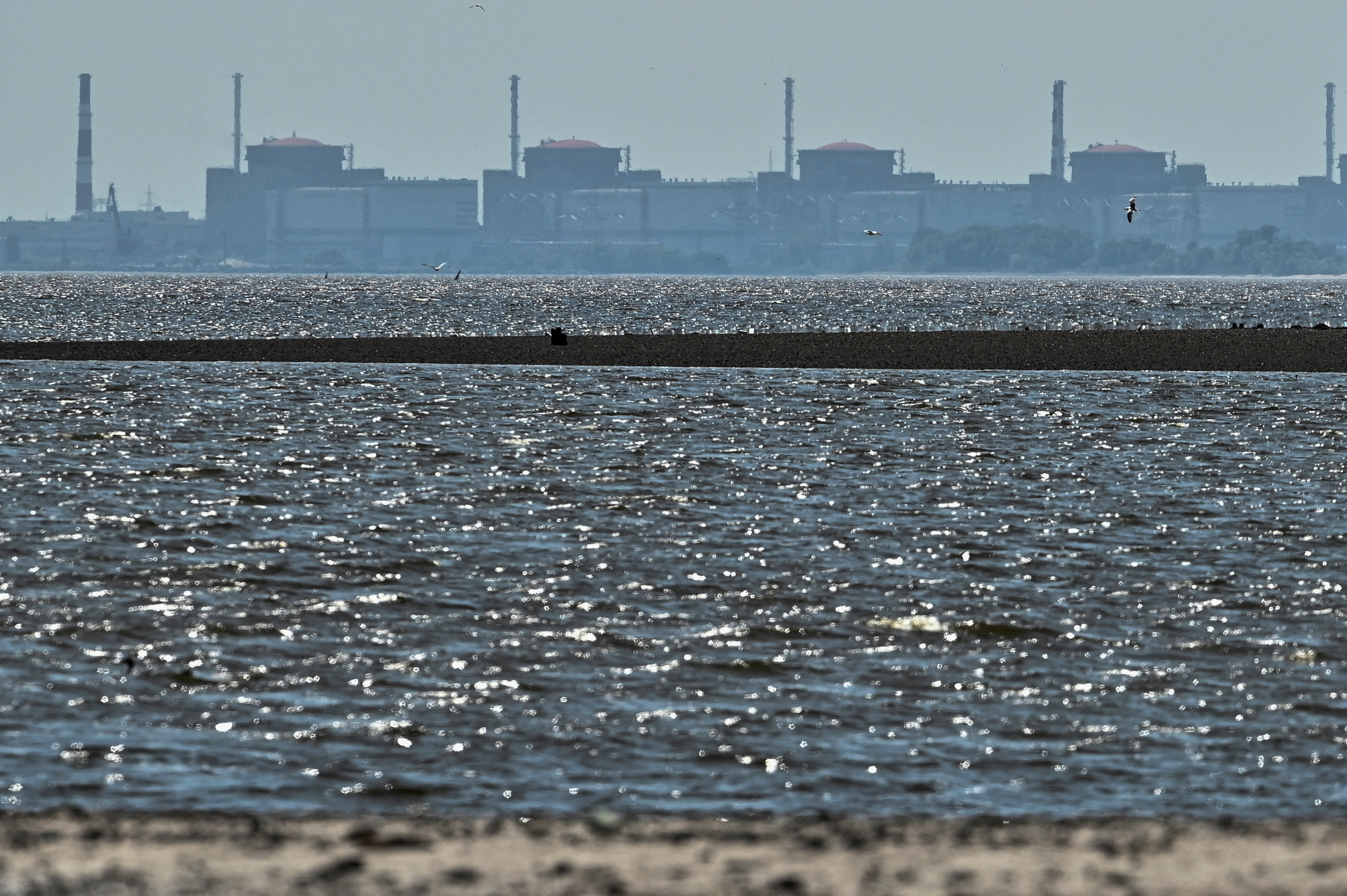By Guy Faulconbridge
June 13, 2023

A view shows Zaporizhzhia Nuclear Power Plant from the bank of Kakhovka Reservoir near the town of Nikopol, after the Nova Kakhovka dam breached, amid Russia's attack on Ukraine, in Dnipropetrovsk region, Ukraine June 9, 2023. REUTERS/Stringer/File Photo
MOSCOW, June 13 (Reuters) - Russian President Vladimir Putin in March announced a plan to deploy tactical nuclear weapons in Belarus, Moscow's first move of such warheads outside Russia since the 1991 fall of the Soviet Union.
What is known about the deployment?
WHAT DID PUTIN SAY?
Putin's nuclear deployment is a message to the West that he will not back down over the Ukraine war.
Putin made the announcement, almost as an afterthought, in an interview with state television Kremlin correspondent Pavel Zarubin that was first posted on Telegram on March 25.
Putin said the trigger for the decision to deploy in Belarus was an announcement by Britain that it would supply depleted uranium munitions to Ukraine. The Wall Street Journal reported on June 13 that the United States is also set to approve depleted uranium tank rounds for Ukraine.
Belarus said the deployment was in answer to the West's "aggressive policy" and that it was aimed at forcing the West's leaders to think before escalating further.

A view shows Zaporizhzhia Nuclear Power Plant from the bank of Kakhovka Reservoir near the town of Nikopol, after the Nova Kakhovka dam breached, amid Russia's attack on Ukraine, in Dnipropetrovsk region, Ukraine June 9, 2023. REUTERS/Stringer/File Photo
MOSCOW, June 13 (Reuters) - Russian President Vladimir Putin in March announced a plan to deploy tactical nuclear weapons in Belarus, Moscow's first move of such warheads outside Russia since the 1991 fall of the Soviet Union.
What is known about the deployment?
WHAT DID PUTIN SAY?
Putin's nuclear deployment is a message to the West that he will not back down over the Ukraine war.
Putin made the announcement, almost as an afterthought, in an interview with state television Kremlin correspondent Pavel Zarubin that was first posted on Telegram on March 25.
Putin said the trigger for the decision to deploy in Belarus was an announcement by Britain that it would supply depleted uranium munitions to Ukraine. The Wall Street Journal reported on June 13 that the United States is also set to approve depleted uranium tank rounds for Ukraine.
Belarus said the deployment was in answer to the West's "aggressive policy" and that it was aimed at forcing the West's leaders to think before escalating further.
WHAT WEAPONS WILL BE DEPLOYED AND WHERE?
Putin said that "tactical" nuclear weapons - so called as they are designed for battlefield use - would be sent to Belarus but did not say exactly which warheads would be deployed or where.
Putin said Iskander mobile short-range ballistic missiles, which can deliver nuclear warheads, had already been handed over to Belarus. Russian sources say the Iskander has a range of 500 km.
Putin also said 10 Belarusian aircraft had been adapted to carry the warheads. Belarus said Su-25 aircraft had been adapted to carry the warheads. The Sukhoi-25 jet has a range of up to 1,000 km, according to Russian sources.
The Federation of American Scientists has said the weapons could be based at Lida air base, just 40 km from the Lithuanian border.
WHEN?
Putin said Russia would finish the construction of a special storage facility in Belarus on July 7-8 and the weapons would be deployed soon afterwards.
Lukashenko has made different comments. He seemed to indicate last month that the weapons were already on the move while on June 13 he said the weapons would be deployed in "several days".
He has also said that there could be "nuclear weapons for everyone" who joined the Russia-Belarus union.
WHO CONTROLS THEM?
Putin said Russia would remain in control of the weapons just as the United States controls its own tactical nuclear weapons deployed in Europe.
The United States has had nuclear weapons deployed in Europe since the 1950s at NATO bases for possible use against the Soviet Union.
Putin has repeatedly raised concerns about the 200 U.S. B61 tactical nuclear warheads deployed at bases in Belgium, the Netherlands, Germany, Italy and Turkey.
Those U.S. warheads are kept in vaults at air bases and the United States keeps the Permissive Action Link (PAL) codes used to arm the weapons.
Russia's nuclear weapons are controlled and transported by the 12th Main Directorate of the defence ministry (12th GUMO).
NUCLEAR RISKS?
After the Soviet Union collapsed in 1991, the United States went to enormous lengths to ensure that the Soviet nuclear weapons stationed in Belarus, Ukraine and Kazakhstan were returned to Russia - which inherited the Soviet nuclear arsenal.
By putting nuclear weapons back in Belarus, Putin is showing that the architecture of post-Cold War nuclear arms control is crumbling.
WHAT IS THE US/NATO RESPONSE?
The United States has criticised Putin's nuclear deployment but has said it has no intention of altering its posture on strategic nuclear weapons and also that it has not seen any signs Russia is preparing to use a nuclear weapon.
"We have not seen any reason to adjust our own strategic nuclear posture, nor any indications Russia is preparing to use a nuclear weapon," the State Department said on March 27. "But candidly, this announcement is one that we condemn."
NATO Secretary General Jens Stoltenberg said on April 18 that Putin's move was irresponsible.
Reporting by Guy Faulconbridge; Editing by Nick Macfie
No comments:
Post a Comment